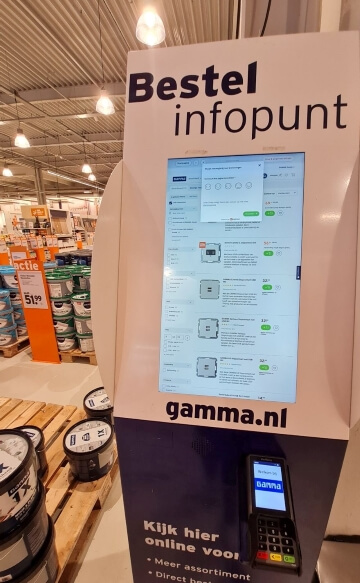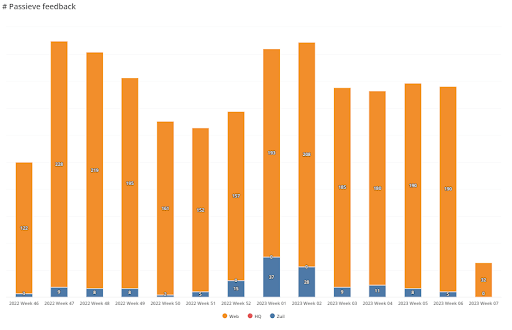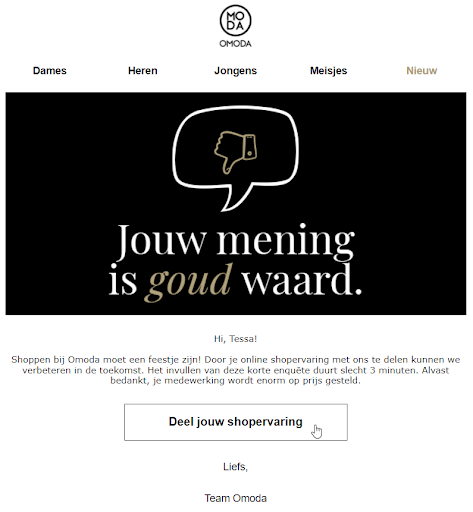Let’s get phygital, phygital… Many retailers nowadays operate both offline and online. In addition to physical stores, they opened online webshops due to technological and societal changes over the years, especially in the last 3 years (let’s not mention the C-word again). But the time of going shopping and visiting physical stores isn’t over. Many consumers actually enjoy going to the mall for some good old windowshopping. And as a result, the entire customer journey is taking place both online and offline. To illustrate: at home, a consumer researches products by visiting different webshops, reads reviews and scrolls through social media. Then they visit the store to look at the product in real-life. And the purchase itself? They do this online through their smartphone. Online and offline experiences are blending in together – physical and digital – which is referred to as the Phygital experience.
In this article, we will look at what the Phygital experience actually is, why it’s important to connect the online and offline experience and how to measure both. As we have plenty of customer stories about how feedback is collected online, we will take a look at how three companies combine these efforts with offline experiences.
What is phygital experience?
The phygital experience is a combination of the offline (physical) experience and the online experience. It’s a bridge between the two environments and aims to offer a seamless and intuitive experience, no matter what channel the customer is on.
An example of a phygital experience is looking for product information or prices on a smartphone while being in the physical store. Or a computer terminal in a store to look at different colors and sizes in the online store. These are all just simple examples, but companies are investing in more advanced phygital experiences using AI and augmented reality. For example, testing make-up or clothes on yourself through your smartphone camera and live video shopping.

Example of Phygital, a terminal to scan a QR code on a reception desk
Why is it important to invest in the Phygital experience?
The phygital experience needs to add value to the customer and make the customer journey easier. When I am in a shoe store and I need my smartphone to see if they have the shoes in different colors, it’s not a great experience. I want to know that without getting my phone out of my pocket. Whenever you can use technology to support and improve physical experience and vice versa, you should invest in the Phygital experience. This will lead to a more frictionless customer journey and one brand experience.
While phygital is a mix of both environments, the experience should be the same and the transition between the channels should be smooth. If a customer looks for a product in the webshop, and then visits the store to buy the product, the experience should be equally great. That’s something you might want to measure. How else would you know that there is a disconnect in the experience? Or what you need to improve upon in both environments?
How to measure the phygital experience?
You can measure the online and offline experience in multiple ways. Let’s take a look at a few examples.
Measuring the experience online
- Customer feedback is one of the easiest ways to collect qualitative feedback on your digital channels. If you want to know what your customers think of your website, app or emails and their experience, simply ask for feedback through feedback forms. Get to know exactly what your customers want, what you need to improve, and what is already working online.
- Marketing analytics (like Google Analytics) can get you quantitative data on how your customers interact with your digital channels. For example, bounce rate, pages visited and conversions that give you an indication of how your customers experience your channels. If you see a page with a large drop in session duration, it’s time to act.
- Support tickets. The number of support tickets can show how satisfied your customers are. Looking into the details can reveal areas for improvement for the customer experience.
Measuring the experience offline (physical)
- Collecting feedback in a physical store can, of course, be done verbally. Employees can ask the customer questions about their experience and play a big part in improving the customer experience. While this information isn’t directly stored, the employees can pass along feedback to upper management or directly use the feedback. And hey, verbal complaints are also feedback!
- The offline experience can also be monitored using a feedback terminal, where a customer can click on how they would rate the experience. For example, in the airport you might see a feedback terminal where you can click on a smiley to indicate your level of satisfaction.
- A little old-fashioned, but sometimes you can give feedback through a paper form or through a suggestion box in the physical store.
How to measure the physical experience with Mopinion?
While Mopinion is primarily used to measure the online experience, there are ways to collect feedback about the experience in physical stores as well. Let’s look at how some of our customers do this.
Intergamma
One organisation that collects feedback in both the online and physical store is Intergamma, the parent organisation behind two large DIY hardware stores in the Netherlands; Gamma and Karwei. In the physical store, there are multiple digital terminals where customers and employees can look for information and products in the webshop. There they have the same passive feedback form you would see when you’d visit the website on your phone or computer. Customers (but also employees) can give feedback in the store. For example, when the product information isn’t detailed enough, or when a feature doesn’t work well. In fact, most of the feedback comes from employees who are assisting a customer, according to Intergamma.

A Mopinion feedback form on the terminal in the Gamma store
While they use the same feedback form in the webshop and on the terminal, Intergamma tracks where the feedback comes from. In the screenshot below, the orange bars demonstrate the number of feedback items from the website, while the blue bars show the feedback items from the terminal. You can see that there is way more feedback given on the website. That makes sense, as the terminals have way less traffic and they do not actively promote the feedback button. But it does give them insights on the experience in the physical store, and the open comment option informs them about possible improvements.

Bar chart from Intergamma’s dashboard in Mopinion
Omoda
Omoda is a well-known fashion store in the Netherlands with several physical stores and an extensive webshop. They collect the customer experience feedback in both places. A lot of the incoming feedback is about the experience in the physical store. Let’s take a look at how Omoda approaches this.
Omoda has a loyalty program from which customers can get multiple benefits. If a member buys a product in the physical store or comes to pick up an online order, it will be linked to the customer system that contains their e-mail address. After a visit, they might receive an invitation via email to provide feedback about the experience. That is, of course, not after every purchase, but members can be invited to this once every 6 months.
In the feedback form, customers are asked to what extent they would recommend Omoda to friends and family. Omoda measures the Net Promoter Score (NPS) here. After the NPS question, a number of questions are asked about the extent to which customers find Omoda inspiring, ambitious and surprising. With these questions, Omoda measures how customers feel during a visit to the store.

Omoda survey invite email about the in-store experience
The feedback is used to track customer satisfaction and loyalty per store. Each store has its own NPS. The store manager, or the person responsible for Mopinion in-store, has access to the software and their own dashboard. In the dashboard they can track the NPS on a daily basis. The store then decides what to do with the feedback. They can immediately start making improvements, or discuss the feedback with the team during the daily catch-up. One of the stores even writes a column about the feedback for their intranet. In addition to the points of improvement, it can also be said that Omoda receives a lot of compliments. How nice!
Omoda is currently optimising the feedback forms to extract more data. They don’t receive enough open comments, which actually produces a lot of valuable data. That is why they now want to work with checkboxes in which the customer can indicate exactly what they like about a visit and why they made the purchase. Is that the friendly staff? The extensive collection? The look of the store? Or something else? Using the checkbox in the form, Omoda gains insight into what the customer values the most in the store and what still needs work.
What’s also nice to mention is that there is an internal challenge for the NPS. The store that achieves the highest increase in NPS compared to last year wins a prize. What can’t you use Mopinion for? So far, the challenge has resulted in a very high NPS score, so that’s promising for the rest of the year.
Albert
Albert is one of the largest retailers in the Czech Republic, with well over 330 stores. Customer’s feedback is very important to them, and thanks to it, they can get even better, and the customers will be more satisfied. They have expanded their feedback collection beyond online channels to include in-store experiences as well. And they have found a creative way to do so. Let’s take a look.
Albert has a loyalty program app that includes recipes, product information and even offers personal discounts, and a credit system. With the credit system, customers can exchange their credits for CZK (Czech Korunas) and use this as a discount on their next purchase. When customers make purchases in-store, they can scan their personal code from the loyalty app to receive (their personal) discount and credits. It also offers higher discounts for selected products as well as personalized offers (i.e. extra credits for the most purchased products).
After the purchase, the customer receives push notifications in the app thanking them for their purchase and offering information on their discounts and credits. Another notification invites them to share their feedback about their in-store experience through a Mopinion form in the app. The feedback form includes an NPS question on a scale of 0 to 10, an open-ended question to explain the rating, and a question to rate a competitor’s store (i.e. the competitor that the customer most recently visited). To avoid overwhelming customers, Albert does not ask the customers for their feedback after each purchase, but continuously.
To ensure they can analyze and follow up on feedback, Albert includes data elements in the form to link it to the evaluated store. The customer service team reviews the feedback to identify any issues and all relevant feedback is immediately reported back to the right store.
The anonymized feedback and NPS are going to be exported to an internal reporting tool, so it can be tracked on a daily basis. This way, all data is stored in a centralized location and can be compared to other data sources. The NPS serves as a key metric used throughout the organization and is even compared to other regions and countries.
Although they’ve only started recently, Albert receives a lot of positive feedback from their customers with a good response rate. Now Albert can compare the performance of different stores and even compare itself to competitors, gaining valuable insights to improve customer experience across all stores. And even more amazing, this high response rate is achieved without any additional marketing communication support or customer rewards.
Start investing in the phygital experience
Phygital is up and coming, as it combines the best of both the online and offline worlds. We’re just at the forefront of technological advancements that will blur the lines between physical and digital. While we’re excited to see more of AI, VR and AR in real-life, we think it’s important to already start laying the groundwork for creating a smooth and seamless experience on all channels (including offline). That’s why it’s nice to see that some companies already collect customer feedback in both environments to improve the overall brand experience.
While Mopinion is primarily used for collecting feedback on digital channels, it is thanks to its advanced customisation and targeting options that it can be applied to specific needs.
Ready to see Mopinion in action?
Want to learn more about Mopinion’s all-in-1 user feedback platform? Don’t be shy and take our software for a spin! Do you prefer it a bit more personal? Just book a demo. One of our feedback pro’s will guide you through the software and answer any questions you may have.






